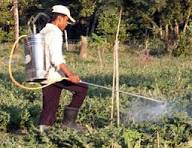Despite increased food production from technological advances in agriculture, substantial quantities of harvested food are lost due to inadequate protection of stored products.
According to an FAO estimate, insect infestation causes about 10 percent or more losses in developing countries.
Losses may be greater now with increased focus on establishing national and international buffer stocks to mitigate production irregularities from unpredictable climatic conditions.
Public outcry against synthetic pesticides in agriculture cannot overshadow their necessity, nor is a rapid decline in their use foreseen. Protecting consumers of treated produce and educating pesticide users are imperative.
Chemical pest control methods, when applied intelligently and knowledgeably, can be effective and safe.
Knowledge of pesticide classification, mode of action, properties, metabolism, and residues is crucial for users to assess benefits and potential hazards, enabling judicious insecticide selection and efficient control measures in specific circumstances.
Pesticide application refers to the practical delivery of pesticides, including herbicides, fungicides, insecticides, or nematode control agents, to biological targets (e.g., pest organisms, crops, or other plants).
Public concern about pesticide use underscores the need to optimize this process to minimize environmental release and human exposure (including operators, bystanders, and consumers).
Read Also: Sheep Production Guide
Spray Application Techniques in Conventional Agriculture

One of the most common pesticide application methods, especially in conventional agriculture, is the use of mechanical sprayers. Hydraulic sprayers consist of a tank, a pump, a lance (for single nozzles) or boom, and a nozzle (or multiple nozzles).
Sprayers convert a pesticide formulation, often a mixture of water (or another liquid carrier, such as fertilizer) and chemical, into droplets, ranging from large rain-type drops to tiny, almost-invisible particles.
This conversion is achieved by forcing the spray mixture through a nozzle under pressure. Droplet size can be adjusted using different nozzle sizes, altering pressure, or both. Large droplets are less prone to spray drift but require more water per area covered.
Small droplets, influenced by static electricity, maximize contact with target organisms but require very still wind conditions.
Pre- and Post-Emergent Pesticide Application for Crop Protection
Traditional agricultural pesticides are applied either pre-emergent or post-emergent, referring to the plant’s germination status.
Pre-emergent application aims to reduce competitive pressure on newly germinated plants by eliminating undesirable organisms, maximizing water, soil nutrients, and sunlight for crops.
Examples include atrazine for maize and sorghum and 2,4-Dichlorophenoxyacetic acid (2,4-D) for rice. Glyphosate mixtures are often applied pre-emergent to remove early-germinating weeds, preparing fields for subsequent crops.
Pre-emergent equipment typically has large, wide tires to float on soft soil, minimizing compaction and damage to unemerged crops. Three-wheel machines ensure tires avoid the same path, reducing ruts and sub-soil damage.
Post-emergent application uses specific chemicals to minimize harm to desirable plants. For example, 2,4-D injures broadleaf weeds (dicots) but spares grasses (monocots), widely used on wheat.
Genetically modified organisms, like glyphosate-resistant soybeans and Bt maize, alter post-emergent formulation needs. Even with appropriate chemicals, high temperatures or environmental factors can harm non-targeted crops during application.
As plants are already germinated, post-emergent application requires limited field contact to minimize crop and soil damage.
Industrial equipment uses tall, narrow tires and adjustable sprayer bodies for crop height, often labeled “high-clearance.” Wide booms (up to 120 feet) minimize field passes, reducing crop damage.
Aerial application top-dresses emerged crops, avoiding soil and crop contact. Knapsack sprayers, fitted with herbicide or insecticide nozzles, adjust flow rates for adequate pesticide discharge.
Air Blast and Fogging Systems for Specialized Crop Protection
Air blast sprayers, also known as air-assisted or mist sprayers, are used for tall crops like tree fruit, where boom sprayers or aerial application are ineffective.
These sprayers are suitable where overspray (drift) is less concerning, using chemicals safe for desirable organisms or adequate buffer distances.
They target insects, weeds, and other pests affecting crops, humans, or animals by injecting liquid into a fast-moving air stream, breaking large droplets into smaller particles.
Foggers, producing very small particles, use pistons or bellows for stagnant pesticide areas, ideal for enclosed spaces like houses or animal shelters, or for space treatment in ship cargo, orchards, or tall structures.
Read Also: Fattening of Sheep and Goats Guide
Factors Contributing to Pesticide Spray Inefficiencies

Numerous factors cause spray inefficiencies. Pesticides applied during high daytime temperatures often evaporate, contributing to air pollution.
Application early in the morning or late evening, when temperatures are lower, is advisable. Drift, where wind carries pesticides away from targets, also causes air pollution.
Surface runoff washes pesticides into rivers or ponds, contaminating aquatic environments. Seepage and leaching into groundwater pollute soil and water. Herbicide volatilization, the evaporation or sublimation of volatile herbicides like 2,4-D or dicamba, reduces effectiveness and may harm unintended plants downwind.
Prompt soil incorporation can mitigate volatilization, influenced by wind, temperature, and humidity (lower humidity increases it). Late-season application on herbicide-resistant genetically modified plants heightens volatilization risk due to higher temperatures and impractical soil incorporation.
Pest Biology and Droplet Size in Targeted Control
Understanding pest biology and life cycles is critical for determining droplet size. For effective corn earworm management, pesticides must penetrate corn silk, where larvae hatch.
Larger droplets best penetrate targeted corn silk, emphasizing the importance of knowing the pest’s damage origin to optimize pesticide application.
Do you have any questions, suggestions, or contributions? If so, please feel free to use the comment box below to share your thoughts. We also encourage you to kindly share this information with others who might benefit from it. Since we can’t reach everyone at once, we truly appreciate your help in spreading the word. Thank you so much for your support and for sharing!
Frequently Asked Questions
We will update this section soon.

